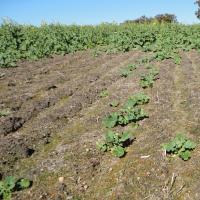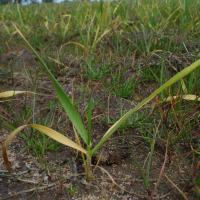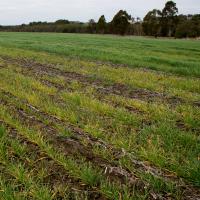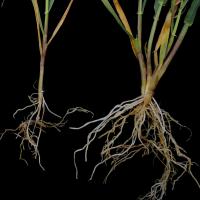Diagnosing waterlogging in cereals
Waterlogging occurs when there is insufficient oxygen in the soil pore space for plant roots to adequately respire. Root harming gases such as carbon dioxide and ethylene also accumulate in the root zone and affect the plants.
What to look for
- Poor germination or pale plants, in water collecting areas, particularly on shallow duplex soils.
- Wet soil and/or water-loving weeds present.
- Early plant senescence in waterlogging prone areas.
Paddock
- Plants are particularly vulnerable from seeding to tillering with seminal roots being more affected than later forming nodal roots.
- Waterlogged seed will be swollen and may have burst.
- Seedlings may die before emergence or be pale and weak.
- Waterlogged plants appear to be nitrogen deficient with pale plants, poor tillering and older leaf death.
- If waterlogging persists, roots (particularly root tips) cease growing, become brown and then die.
- Seminal roots are important for accessing deep subsoil moisture. If damaged by waterlogging the plants may be more sensitive to spring drought.
Plant
What else could it be
| Condition | Similarities | Differences |
|---|---|---|
| Diagnosing nitrogen deficiency in wheat | Pale plants with older leaves most affected | Nitrogen deficient plants will have health roots systems and are not only in wet areas |
| Diagnosing potassium deficiency in wheat | Pale plants with older leaves most affected | Potassium deficient plants will have health roots systems and are not only in wet areas |
| Diagnosing molybdenum deficiency in cereals | Poorly tillered plants | Molybdenum deficiency is more scattered, affects the middle leaves, it causes white/no heads or delayed maturity |
| Diagnosing root lesion nematode in cereals | Poorly branched roots | Waterlogged plants only occur in wetter areas |
|
Trifluralin damage
|
Brown poorly branched roots | Herbicide damage correlates with a spraying event |
Where does it occur?
- Water accumulating or poorly drained areas such as valleys, at the change of slope or below rocks.
- Duplex soils, particularly sandy duplexes with less than 30 centimetres (cm) sand over clay.
- Deeper sown crops.
- Waterlogging greatly increases crop damage from salinity. Germination and early growth can be much worse on marginally saline areas after waterlogging events.
- Low nitrogen status crops.
- In very warm conditions when oxygen is more rapidly depleted in the soil.
Management strategies
- Sow waterlogging tolerant crops such as oats and faba beans.
- Sow as early as possible with a higher cereal seeding rate.
- Drainage may be appropriate on sandy duplex soils on sloping sites.
- Raised beds are more effective on relatively flat areas and on heavier textured soils, but areas need to be large enough to justify machinery costs.
How can it be monitored?
- Water levels can be monitored with bores or observation pits, but watertables can vary greatly over short distances.
- Plants can be waterlogged there is a water table within 30cm of the surface and no indication of waterlogging at the surface. Observe plant symptoms and paddock clues and verify by digging a hole.
See also
Further information
Page last updated: Thursday, 15 June 2017 - 10:10am





